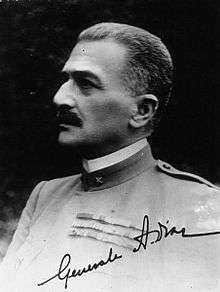Armando Diaz
| Marshal of Italy Armando Diaz OSSA OSML OMS OCI | |
|---|---|
 | |
| Chief of Staff of the Italian Army | |
|
In office 9 November 1917 – 13 August 1919 | |
| Preceded by | Luigi Cadorna |
| Succeeded by | Pietro Badoglio |
| Minister of War | |
|
In office 30 October 1922 – 30 April 1924 | |
| Prime Minister | Benito Mussolini |
| Preceded by | Marcello Soleri |
| Succeeded by | Antonino Di Giorgio |
| Personal details | |
| Born |
5 December 1861 Naples, Kingdom of Italy |
| Died |
28 February 1928 (aged 66) Rome, Kingdom of Italy |
| Nationality | Italian |
| Spouse(s) |
Sarah De Rosa-Mirabelli (m. 1895; d. 1928) |
| Profession | Military officer |
| Awards | see below |
| Military service | |
| Allegiance |
|
| Service/branch |
|
| Years of service | 1884–1924 |
| Rank |
Marshal of Italy General |
| Unit | 49th Division of XXIII Corps |
| Battles/wars | |
Armando Diaz, 1st Duke of the Victory, OSSA, OSML, OMS, OCI (5 December 1861 – 28 February 1928) was an Italian general and a Marshal of Italy. He is mostly known for his role as Chief of Staff of the Regio Esercito during World War I.
Early life
Born in Naples in a family of distant Spanish heritage, he was the son of Lodovico, a navy officer and Irene Cecconi,[1] the daughter of a minor noble. Diaz began his military career as a student at the Military College of Naples, before moving on to the Military Academy of Turin, where he graduated as an artillery officer in 1884. Personally, Diaz was described by a contemporary journalist who saw him at 56 as "medium build, of dark complexion, with black hair turning gray and a slight cast in the eye... His character as a soldier was that of an inflexible disciplinarian who applied to himself the same rules as he enforced on others. In the daily routine of military life, evenly poised, and in the face of danger, characteristically calm."[2]
Military career
He was first assigned to the 10th Field Artillery Regiment. In 1890, with his promotion to captain, he was moved to the 1st Artillery. In 1894, he attended the School of War and ended the courses ranking first in his class. Then, he moved into the Army Staff, and worked in the office of General Alberto Pollio for two years.
In 1899, he received a promotion to infantry major and commanded, for a year and a half, a battalion of the 26th Infantry Regiment.
He reached the rank of lieutenant colonel in 1905, and he served as Chief of Staff in the Florence's Military Division. In 1910, as a colonel, he served in the Italo-Turkish War, commanding the 21st Infantry and, when it lost its commander, the 93rd Infantry. During his Libyan service, he was injured at Zanzur in 1912.[3]
First World War
On the outbreak of World War I, he was assigned to the high command as head of the unit's operations, under General Luigi Cadorna. He was promoted to 2-star general in June 1916, and assumed the command of the 49th division and then the 23rd army corps.
The Battle of Caporetto, in October 1917, was disastrous to the army, and on 8 November 1917, he was called to succeed Cadorna as chief of general staff by 9 November. Having recovered what remained of the army, he organized the resistance in 1917 on the Monte Grappa massif and along the Piave River, which successfully halted the Austrian offensive. In the summer of 1918, he oversaw the victory in the Battle of the Piave River and, later that year, he led the 1.4 million Italian troops in the Battle of Vittorio Veneto, which ended the war on the Italian front. With his famous Bollettino della Vittoria (Victory Address), he communicated the rout of the Austrian army and the victory of the Italians in the war.
Postwar
On 1 November 1921, Diaz was in Kansas City to attend the groundbreaking ceremony for the Liberty Memorial, which was being constructed there. Also present that day were Lieutenant General Baron Jacques of Belgium, Admiral David Beatty of Great Britain, Marshal Ferdinand Foch of France, and General John J. Pershing of the United States. One of the main speakers was Vice President Calvin Coolidge of the United States. In 1935 bas-reliefs of Jacques, Foch, Diaz, and Pershing by sculptor Walker Hancock were added to the memorial.
After the war, Armando Diaz was appointed as a senator. In 1921 he was ennobled by King Victor Emmanuel III and given the victory title of 1st Duca della Vittoria ("Duke of the Victory"). Benito Mussolini named him Minister of War, and he was promoted to Field Marshal. Upon retirement in 1924, he was given the honor of Marshal of Italy (Maresciallo d'Italia). Diaz died in Rome in 1928; he was buried in the church of Santa Maria degli Angeli e dei Martiri, next to Admiral Paolo Thaon di Revel.
Honours and awards
- Supreme Knight of the Order of the Most Holy Annunciation (1919)
- Knight Grand Cross with Grand Cordon of the Order of Saints Maurice and Lazarus
- Knight Grand Cross of the Military Order of Savoy ("Who, having assumed the office of chief of the army in a very difficult war situation, with shrewd work of organization and shrewd effective control line, always highly inspired by the interests of the country, was able to obtain this level of preparation moral and military troops to successfully overcome the ordeal of a great battle engaged by enemy forces and means imposing."; June 26, 1918)
- Silver Medal of Military Valor
- War Merit Cross, twice
- Commemorative Medal for the Italo-Turkish war
- Commemorative Medal for the Italo-Austrian war 1915-18 (4 years of campaign)
- Commemorative Medal for the Unification of Italy
- Commemorative Medal for the Italian victory
- Bailiff Grand Cross of Honour and Devotion of the Sovereign Military Order of Malta
- Médaille militaire (France)
- Distinguished Service Medal (United States)
- Croix de guerre 1914–1918 (France)
- Croix de guerre 1914–1918 (Belgium)
- Commanders Cross of the Order of Virtuti Militari (Poland)
- Honorary Degree from Providence College (1921)[4]
References
- ↑ Irene Cecconi Archived 2015-11-26 at the Wayback Machine.
- ↑ Francis Whiting Halsey. "The Literary Digest History Of The World War Compiled From Original And Contemporary Sources". Richardson Press (March 9, 2010). Page 106.
- ↑ "L'arrivo in Italia dei feriti di Derna e di Zanzur – Lo sbarco a Napoli". La Stampa. 28 September 1912.
- ↑ "Providence College Alembic". Providence College. p. 83. Retrieved 2012-06-17.
| Wikimedia Commons has media related to Armando Diaz. |
| Wikisource has original works written by or about: Armando Diaz |
- This article uses material from the equivalent Italian-language article, retrieved November 16, 2005.
- Who's Who: Armando Diaz
External links
- Newspaper clippings about Armando Diaz in the 20th Century Press Archives of the German National Library of Economics (ZBW)
